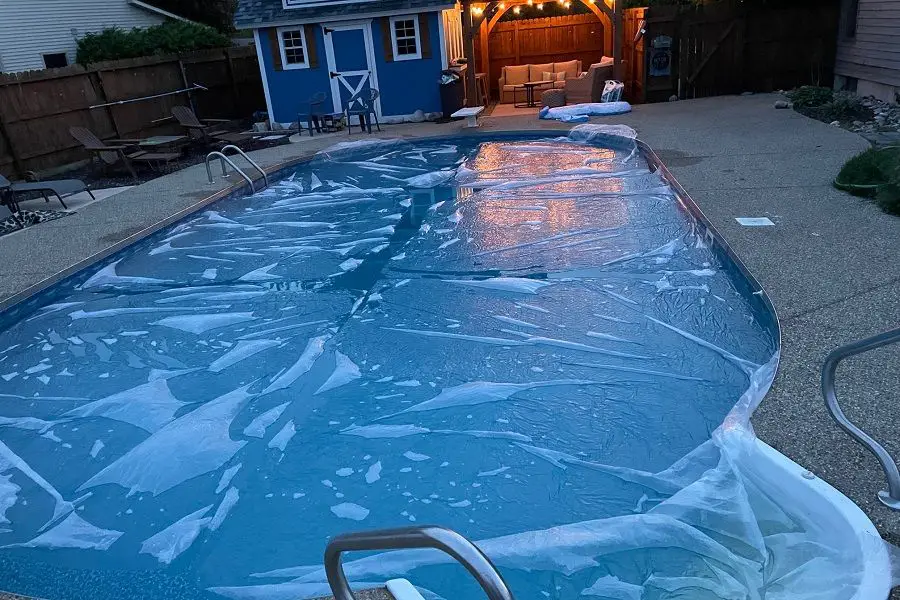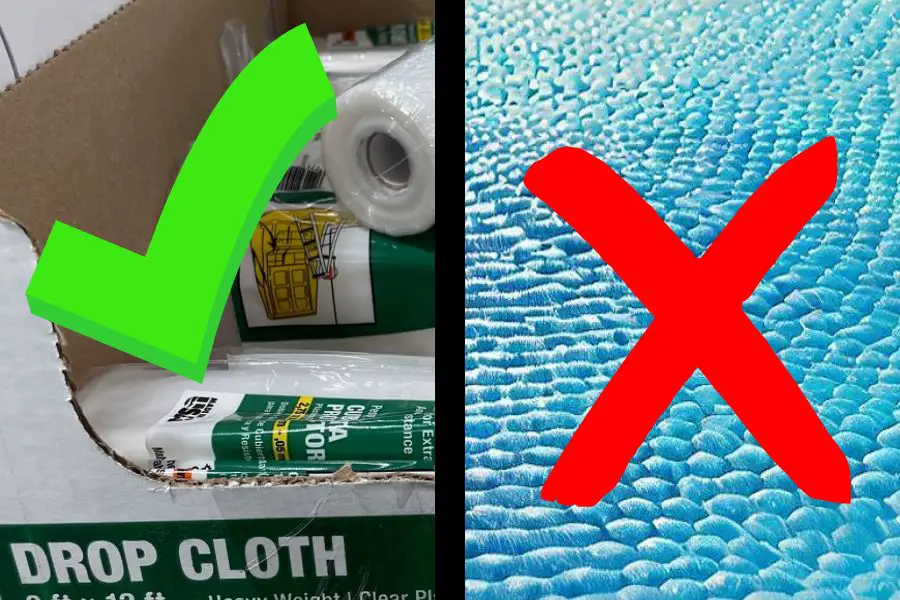Last year we used one of the cheapest DIY pool covers we could come up with. Through the course of use, we found that the homemade cover was able to retain heat similar to that of an expensive store-bought bubble cover.
For our pool size, a traditional bubble cover would cost upwards of $200 and only gives us two seasons before needing replacement. Even with a solar reel, the bubble cover was always cumbersome to move around.
We had so much success in keeping the pool warm with our cheap pool cover last year, we decided to give it another run for a second year. And in all honesty, we truly can’t foresee going back to the traditional bubble cover.
Aside from price, the best part of our DIY pool cover is the simplicity. It’s made up of plastic drop cloths that can be found in most hardware stores. The plastic provides a barrier to prevent evaporation (aka heat loss).
In this post, we wanted to give a quick update on how the DIY pool cover turned out over the course of a full pool season. We’ll also look at an easy improvement that we’re using for our second season.
Let’s jump in!
How the Original DIY Pool Cover Held Up in 2022
Pool season here in Michigan generally runs from Memorial Day through Labor Day. In other words, we usually can rely on a solid three months of warm weather –sometimes we’ll get a few bonus weeks on the front-side or back-side of the pool season.
Even during our normal pool season, we often have plenty of cool nights intermixed which can easily knock down the pool temperature 5 degrees without a cover. Using the plastic drop cloths, we were able to limit temperature drop by 1 to 2 degrees even on the coolest summer nights.
With the combined forces of our pool cover and DIY solar heater, our pool temperature was maintained between 86 – 88°F for most of the season.
To offset the cool nights, we placed our cheap cover onto the pool at least two or three dozen times last year. During the course of use, all six of the 0.7 mil drop cloths survived the entire 2022 pool season without needing replacement, which kept the overall cost under $10!
With all the good, there were a couple of minor drawbacks (by no means a dealbreaker for us!).
Effort to Place the Pool Cover
While we were impressed with how well the solar cover held up last year, it wasn’t necessarily the easiest to place onto the pool. It was somewhat finicky and could bunch up or wrinkle while trying to lay it onto the pool.
We pretty much had to factor in 15 minutes into our evening to allow time to place it onto the pool. Fortunately, this was not a physically demanding endeavor and just tested our finesse with the pool brush.
Pool Cover Only When Pump is Off
With the drop cloths, we also found that we needed to remove them before our single-speed pump started each morning. The 0.7 mil drop cloths were so thin, that they bunched up from the current of the return jets.
While we never had this occur, we saw potential that the drop cloth could get sucked into the skimmer. For pools that rely solely on a skimmer for suction-side circulation, a clogged skimmer could cause significant damage to the pump.
Due to the thinness of our particular drop cloths, we had to ensure we were prompt in our timing of putting them on and taking them off –i.e., cover was on only when the pump was off. We may upgrade our pump someday to a variable-speed, which might allow us to keep the 0.7 mil cloths on the pool when running at low RPM.
Improvement to the DIY Pool Cover for 2023 Season

After much success using the DIY pool cover last year, we couldn’t imagine going back to the monstrous bubble cover. A traditional cover might be considered if we had a nice reel, which also would come with a hefty price tag.
But, with most things, there’s always room for improvement. We decided to trial usage of thicker plastic drop cloths this year to help offset the amount of time it takes to place them onto the pool, and to hopefully allow us to keep it on while the pump is running.
In our first year, we used 0.7 mil thick cloths and briefly experimented with a 2 mil one, which showed some promise. This year we decided to upgrade all six of them to 2 mil.
The 2 mil are nearly three times as thick, and just under twice the cost as the 0.7 mil. Ultimately, we paid $17 total for six 9’ x 12’ sheets at our local home improvement store, which provides nearly 650 square feet of coverage.
Although we’re paying a bit more, it’s still significantly cheaper than the bubble cover.
At the store, we saw even thicker options available up to 4 mil. However, it would have cost nearly $40 to cover our pool. We decided to stay frugal and hope for the best with the 2 mil.
In our few weeks using the 2 mil cover, here’s the rundown of what we saw.
Heat Retention
As expected, the 2 mil cover has provided excellent heat retention.
We’ve had some nights where temperatures have dipped into the 40s and 50s, and the pool water only drops a degree or two when using the cover. Its effectiveness can be seen simply through watching fog rising from any gaps where the water is left uncovered, while the covered portion remains fogless.
With that in mind, the thicker 2 mil cover doesn’t retain heat anymore noticeable than the thinner 0.7 mil cover. The difference in thickness is not really enough to add measurable insulation value.
The overall goal of the plastic drop cloths is to provide a barrier between the air and the pool water. This will prevent cold air from sucking the heat out of the pool.
Regardless of whether you’re using a thin or thick cover, they’ll both be able to prevent this evaporation in similar fashion. With gaps in between sheets we only cover about 90% of the pool’s surface, but we still see great results.
Easier to Place On Pool
Ease of use is really where the thicker 2 mil cover shines. While the 0.7 mil cover was effective last year, it was a bit tedious spending 15 minutes trying to lay it on the pool with the pool brush.
The same process can still be used as that of the 0.7 mil cover. But, this year we’ve found that much less time is needed to brush the cover into position.
Since data is always useful, we’ve timed just how long it takes to lay the six sheets onto the pool. We’re averaging right around 9 minutes after a handful of uses. In other words, about 40% less time spent laying this cover compared to last year’s.
Using this thicker cover puts the duration on par with our past experience with a traditional bubble cover, while still being much less physically demanding or cumbersome.
Run Pump While Cover is On
One of the largest downfalls with the 0.7 mil cover last year was finding that it’d be bunched up on one side of the pool if the pump was running.
This was partly due to our single-speed pump that always runs at full speed. Additionally, our jets are angled upwards slightly to improve surface circulation, which would also move the thin cover around.
With the 2 mil cover, we’ve seen vast improvement likely due to their increased rigidity that is inherent with being thicker.
We’ve allowed the pump to run while the cover is on and have only seen slightly shifting in the pool. Overall, they’ve been able to still maintain 80 to 90% coverage with the pump running even when slightly bunched.
From our first couple weeks with the 2 mil cover, we no longer feel rushed to pull it off the pool before the pump starts.
However, we still ensure that both our drain and skimmer ports are open when using the cover. By having the main drain open it protects the pump in the event that a portion of the cover gets pulled into the skimmer, as water will continue to be pulled from the drain.
Durability
With nearly triple the thickness, the 2 mil cover physically feels more robust than the grocery bag-like 0.7 mil cover. The thicker cover seems to be less prone to small holes that could occur during brushing.
We hang our sheets on the railing to dry, and sometimes a breeze can cause them to whip around in the wind a bit. The added thickness will help prevent tears when this happens.
Sinkage
While the thickness adds durability, it also adds a bit more weight. By weight, we’re talking ounces, which won’t add any noticeable physical demand.
However, a couple times we’ve seen a portion of the edges sink down into the water a bit, more so than what we saw with the 0.7 mil cover. This sinkage may lessen the effective coverage of the plastic sheets, but they’ve still been able to do the job.
Ultimately, this may be a small tradeoff of using the thicker plastic sheets and something to consider if looking to go the route of a DIY pool cover.
Performance of DIY Cover Compared to Bubble Cover
Traditional bubble covers range in thicknesses from 8 mil to 16 mil –in other words, about 1/16 to 3/16” thick. Greater thickness will likely help prevent premature tearing, but might not actually help much with the imminent disintegration of the bubbles.
This year’s thicker 2 mil DIY cover is less than 1/32” thick.
Fortunately, the differences in thickness between traditional and DIY covers are pretty much negligible when it comes to heat retention. A thin layer of plastic food wrap could still prevent evaporation of pool water similar to a bubble cover (although good luck trying to place it on the pool!).
The primary benefit of the bubble cover is that it’s easy to trim it to fit the exact shape of the pool to get nearly 100% coverage. If using a reel, the cover can easily be placed onto the pool in the same orientation each time without too much fuss.
If using more than one plastic drop cloth, it’s likely that you’ll have some gaps between sheets, but it’s still simple to obtain 90% coverage. Even without 100% coverage like a bubble cover, the 90% cover will still provide great efficiency.
Final Takeaway
In our opinion, the benefits that come with the thicker drop cloths easily make up for the slight uptick in cost relative to last year’s thinner cover. Even so, the cost is still only a small fraction of the typical bubble covers.
Compared to last year’s cover, the 2 mil version is much easier to place onto the pool and has proven more successful in holding place while the pump is running. All that, while still achieving its main purpose of preventing evaporation and keeping the pool warm on those cool nights.
We’re looking forward to another season of keeping the pool warm for cheap!
Happ (warm) Swimming!
Husband and father of three (actually, four if you include the pool). I’m an avid DIY-er and weekend warrior that enjoys taking up new projects around the house to help us maximize leisure right at home. I enjoy researching and sharing various tips, tricks and knowledge to help others make their home an oasis.

